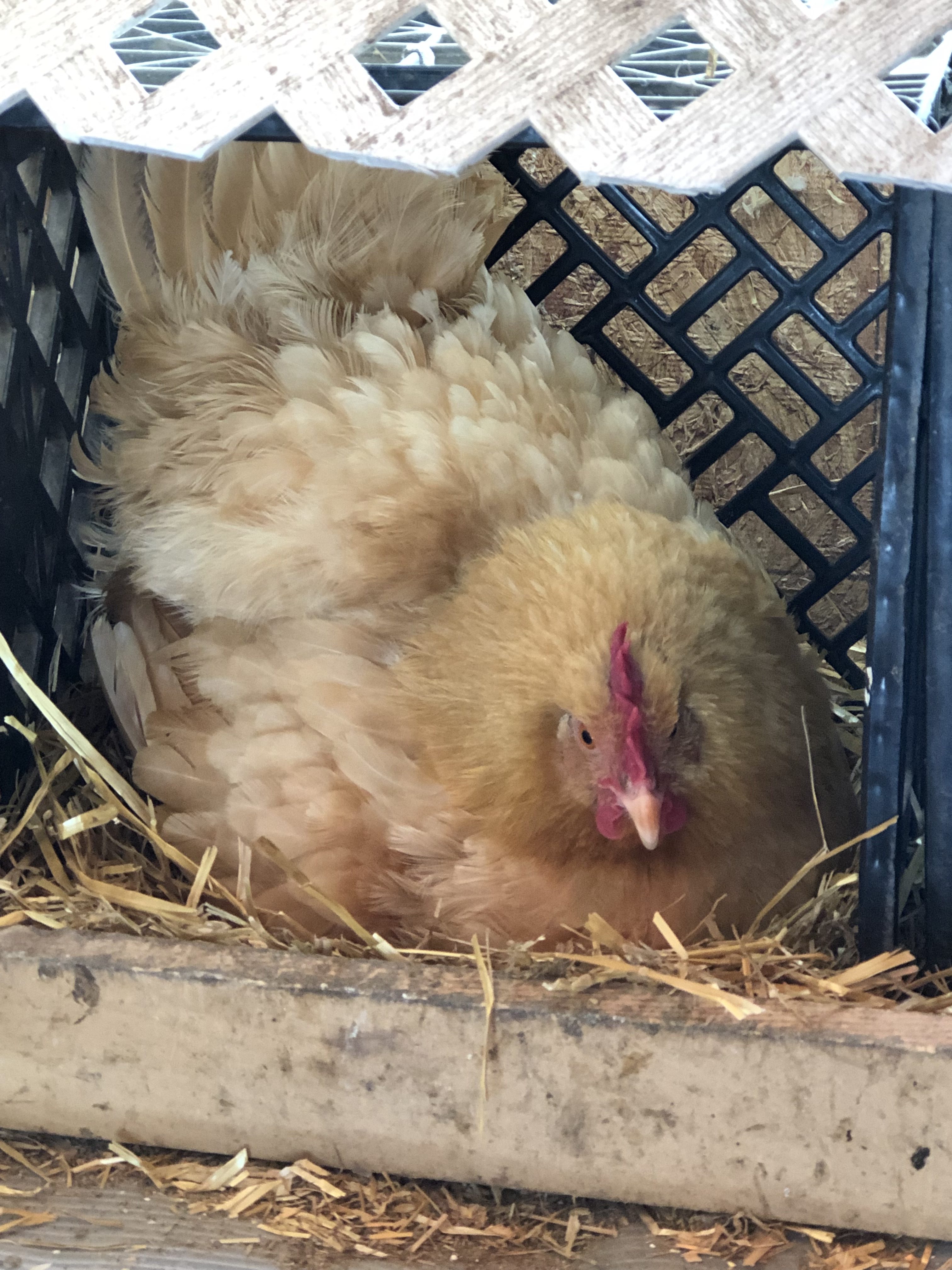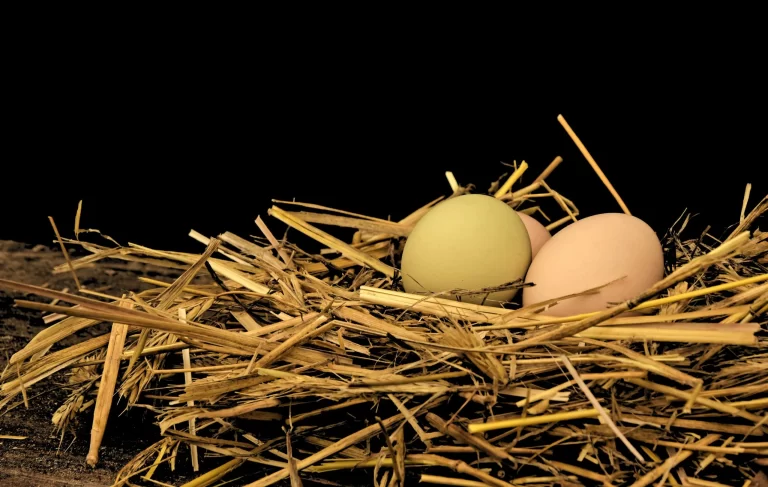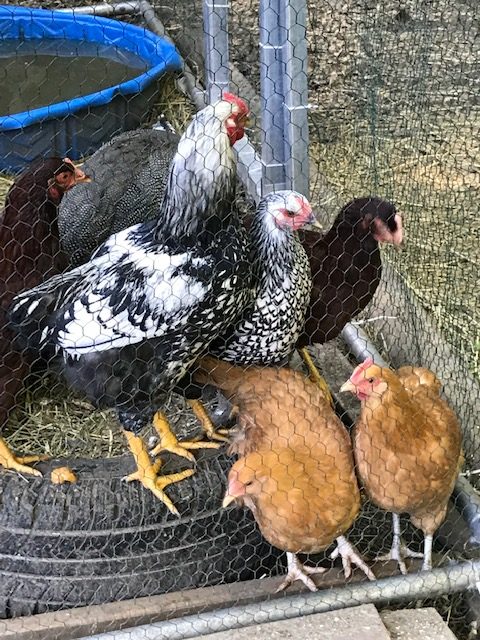Is my hen broody or egg-bound? How to tell
(This post may contain affiliate links. See the full affiliate disclosure here for more info.)
Yesterday, I found myself asking if my hen was broody or egg-bound—having trouble passing an egg. I really didn’t know much about an egg-bound chicken but had run across Pinterest pins on the topic, so I was aware that it could happen. But that was it.
It’s winter here in Vermont, and my birds spend the day in a covered outer pen until they wander back into the coop. The cover keeps the snow off and their feet from getting too cold as the floor is elevated off the ground. I let the birds out every morning through a sliding door from the coop into the pen.
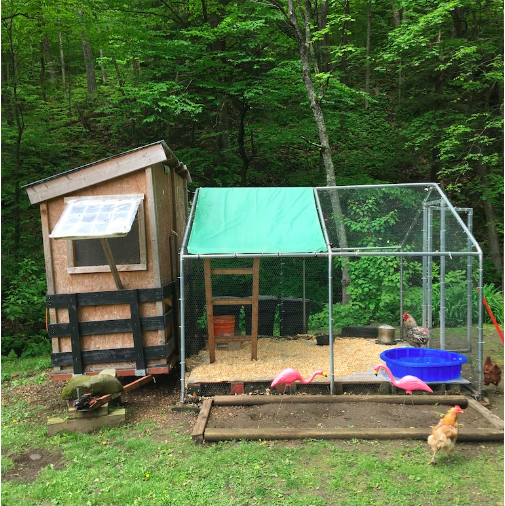
This morning I realized that my Buff Orpington hen (I call her Buffy 2) was still sitting in the nesting box since the previous afternoon. She looked “fluffier” than usual, and I retrieved a couple of eggs from under her.
When she was still in the nest box at dusk, when I let the birds back into the chicken coop, I figured that we (she) might have a problem, so I looked up some signs and facts about broody hens and egg-bound hens.
Broody hens
Broody hens want to be or think that they are mamas. It’s an urge driven by hormones or instinct.
A broody hen wants to hatch her eggs—or any eggs she finds to sit on. Of course, if the eggs aren’t fertile, they will never hatch.
We do have a rooster, so the eggs she was sitting on might have been fertile and might have eventually hatched. I’m not crazy about hatching chicks in the dead of winter, so I really didn’t need her help in trying to hatch these eggs.
Signs of a broody hen
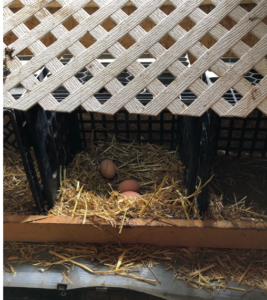
- If she has access to them, she may roll all the eggs she can find into a clutch of eggs that she sits on
- She will sit in the nesting box or on the eggs all night and won’t roost with the rest of the birds
- She will only leave to eat
Problems with a broody hen
The good news is that this isn’t a life-threatening condition, and if you have a rooster, you certainly can let a hen incubate a clutch of eggs. This is a pretty common problem with backyard chickens.
What to do with a broody hen
Broody behavior can become compulsive and should be broken. However, your hen may react aggressively if you try to remove her from her clutch. To break the behavior, you have to remove her from the environment or make her sense it differently.
Remove the bird from the nesting box in the morning and put her with the other birds. Block her access to the nest box if possible.
You may want to make the environment less conducive to nesting by cooling the floor. You can add a bag of frozen vegetables or cut a small hole in the floor of the nesting box to allow for better airflow. You can put her in a cage with a wire floor and no nesting material. That might make her uncomfortable enough to stop trying to nest.
Egg-bound hens
Sometimes a double-yolked or large egg can be difficult for a hen to pass. Thankfully, having a bound egg is a relatively rare occurrence.
Here’s where I had to look up a hen’s anatomy to understand the symptoms of a hen with a retained egg.
The “business end” of a hen has only one opening. It is called the cloaca but often is referred to as the vent. This one opening is used by the hen’s reproductive tract (the hen’s oviduct), digestive, and urinary tracts (i.e., the excrement and eggs exit from the same opening).
Common symptoms of an egg-bound chicken
These are the signs of an egg-bound hen
· The hen may have trouble walking, waddle, or appear to be in pain when walking
· She may appear “fluffy” and pant as if straining
· She may not want to eat
Common causes of egg binding
There are a number of potential causes of a bound egg.
- too much protein in a hen’s diet
- stress
- worms (parasitic infections)
- low-quality feed or poor diet
- dehydration
- weakness from illness
Problems with an egg-bound hen
Here’s where the life-threatening problem occurs. When a hen is egg-bound, the egg may block the normal excretion tracts, causing a backup that can cause an infection in the hen’s abdominal cavity or blockage that will kill the bird in 24-48 hours.
This is a medical emergency in a hen. Thankfully, there are a couple of things you can try before you need to consult a veterinarian.
What to do with an egg-bound hen
Feel the hen’s abdomen GENTLY. If you break an egg within the hen, she may develop an infection and die. Buffy 2’s abdomen was soft.
Before you seek veterinary care, the first thing to try—because it’s not invasive—is to warm the hen’s vent area using moist heat. It goes without saying that this chicken spa treatment should be done in something—a basin or bucket—that you don’t use for other purposes.
I used an old basin. Add warm water. If you have Epsom salts, add one to two cups to several inches of water. This will help to relax the hen.
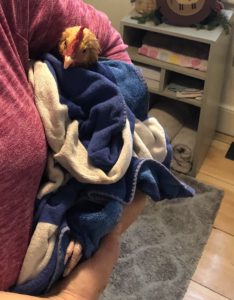
SECURELY hold the bird’s wings to her body and lower her rear end into the warm bath. Hold her there, gently massaging her vent area for 15 to 30 minutes.
The theory is that manual manipulation will help the egg to move down the tract. This can be repeated several times a day to help move the egg along.
The second thing to try is a closer examination. You will lubricate the hen’s vent, the opening from which an egg passes.
My husband held the bird tightly wrapped in a towel and turned her “butt-up.” I used a disposable latex glove lubricated with mineral oil to lubricate the vent area. You can also use KY jelly, vegetable oil, or olive oil.
I have to say that this was much easier and cleaner than I expected. There seemed to be an open chamber on the other side of the vent (inside the bird) that was empty. I don’t know if that was a good or bad sign.
How to prevent egg-binding
A proper diet is important in preventing a bound egg in the first place. Just as humans can’t make nine of the amino acids that they need to make critical proteins, chickens also lack some essential amino acids. Specifically, they can’t make methionine and lysine. These amino acids must be provided in their diet.
Another important component of chicken feed is calcium, which makes sense given the composition of eggshells. Make sure you are giving layer feed to laying hens. An adequate calcium supply is very important.
Buffy 2
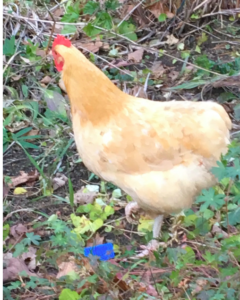
Buffy 2 wasn’t making the noises sometimes associated with an egg-bound hen (a high trilling sound), but In the end, we decided to proceed as if she was egg-bound as that is a very serious health issue. We warmed and massaged her vent area in water and lubricated her vent.
She spent the night in a large crate in the house so that her feathers could completely dry. I couldn’t risk getting her sick from putting her outside in the cold while very wet.
I put her into the outer yard the next morning to eat, but she was in the nesting box again when I went to let the others bird in for the night.
This morning, I found Buffy 2 in the same nesting box she’s inhabited for a couple of days. However, unlike the past mornings, she jumped up as soon as I opened the chicken coop door to the covered play yard.
She ate with the other hens. I found three eggs in the nesting box, so if she was egg-bound, maybe one was hers. If not, she was okay leaving the eggs to eat.

Of course, I’ll be watching Buffy 2 carefully.
She may still be broody. and I’ll be making sure that she goes out in the morning to eat with the other birds if she doesn’t want to go out, I’ll pick her up and move her to the outer pen in an effort to break her broody instincts.
Birds pecking each other raw? Read how to make easy chicken aprons.


